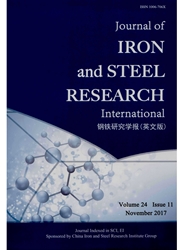

 中文摘要:
中文摘要:
The vanadium titano-magnetite(VTM)iron ore fines of 110-150μm in diameter were reduced in a transparent quartz fluidized bed by 70%CO-30%H2(volume fraction)mixtures.MgO powders served as coating agent to solve sticking problem.Two coating methods were introduced in this experiment:high temperature injection method and briquetting→oxidizing roast→crushing method.According to the experimental results,the minimum effective coating amount of MgO was 0.1mass%.The metallization ratio(MR)of the product rose from around 58% to above90% with the above treatments.To investigate the sticking mechanism of fine ore,the morphology evolution was investigated.Instead of iron whiskers,an interlaced fibrous porous surface formed.The ulvospinel(2FeO·TiO2)in VTM is more difficult to be reduced than FeO according to thermodynamic calculation.XRD results showed that MgO diffused into Fe2O3 lattice before forming pleonaste(MgO·Fe2O3)during oxidizing roast at 1 273 K.The melting point of the pleonaste is 1 986 Kand that made contribution to prevent the sticking problem.
 英文摘要:
英文摘要:
The vanadium titano-magnetite (VTM) iron ore fines of 110--150/xm in diameter were reduced in a trans- parent quartz fluidized bed by 70 %CO-30 % H2 (volume fraction) mixtures. MgO powders served as coating agent to solve sticking problem. Two coating methods were introduced in this experiment: high temperature injection method and briquetting→oxidizing roast→crushing method. According to the experimental results, the minimum effective coating amount of MgO was 0. 1 mass%. The metallization ratio (MR) of the product rose from around 58% to above 90% with the above treatments. To investigate the sticking mechanism of fine ore, the morphology evolution was in- vestigated. Instead of iron whiskers, an interlaced fibrous porous surface formed. The ulvospinel (2FeO : TiO2 ) in VTM is more difficult to be reduced than FeO according to thermodynamic calculation. XRD results showed that MgO diffused into Fe203 lattice before forming pleonaste (MgO · Fe2O3 ) during oxidizing roast at 1273 K. The melting point of the pleonaste is 1986 K and that made contribution to prevent the sticking problem.
 同期刊论文项目
同期刊论文项目
 同项目期刊论文
同项目期刊论文
 期刊信息
期刊信息
